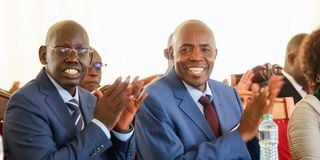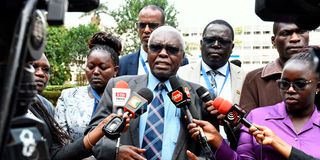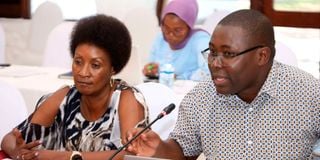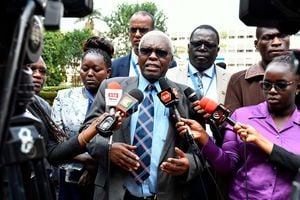
Basic Education Principal Secretary Belio Kipsang with Education Cabinet Secretary Ezekiel Machogu during the release of the 2023 KCPE results on November 23.
Learners in primary and junior school will start the new academic calendar in January with a reduced workload, following a reorganisation of their curriculum by the Ministry of Education.
This will also come as a relief to parents who have complained that implementation of the competency-based curriculum (CBC) is expensive and burdensome to learners.
The learners will not only have fewer subjects but also fewer lessons per day in the first major review of the CBC.
Parents with children in private schools, which are not supported by the government, will now spend less on learning materials as a result of fewer subjects. The government will also purchase fewer textbooks for supply to public schools.
In a communication to regional, county and sub-county directors of education, Basic Education Principal Secretary Belio Kipsang’ said some learning areas have been combined while others have been dropped.
The changes follow recommendations of the Presidential Working Party on Education Reforms (PWPER) that observed that the curriculum was overloaded for the learners and teachers. It tasked the Kenya Institute of Curriculum Development (KICD) to rationalise the learning areas and curriculum designs in terms of scope, integration of subjects within a learning area, gaps, content overload and overlaps.

Presidential Working Party on Education Reform Chairperson Prof Raphael Munavu addressing media during public hearings on education reforms held at the University of Nairobi (UoN) Taifa Hall on November 11, 2022.
“Every cloud has a silver lining. We’ve had to relook the entire basic education and the content has been spread in a way that nothing is lost. The content is now lighter for junior school and much of its depth taken to senior school. Learners in junior school now have a chance of having a taste of all the domains of learning,” KICD chief executive Prof Charles Ong’ondo told the Nation.
Also Read: Education for the rich - Concern as thousands set to miss out in new varsity funding model
He added that the institute has recalled learning materials for areas that have been rationalised. A reorganised curriculum was recommended by the PWPER after stakeholders in the education sector expressed concerns that the CBC content is overloaded, has overlaps and is costly to parents.
“We’ve reorganised the curriculum designs looking at how each sub-area contributes to the other. The rationalisation has been done for all the subjects,” Prof Ong’ondo said.
The number of learning areas for learners in Pre-primary 1 and 2 will remain unaffected (five) as well as the 25 lessons per week. The number of lessons per week for the learning areas at this level are language activities (5), mathematical activities (5), creative activities (6), environmental activities (5), religious activities (3) and pastoral or religious instruction programme (1).
Learning areas for Lower Primary (Grade 1 to 3) have been reduced from the current nine to seven and the number of lessons from 35 to 31 per week. Hygiene and nutrition activities, which previously was a stand-alone subject, has been integrated within environmental activities.
Movement and creative activities has been renamed creative activities and will comprise art, craft, music and physical education with a total of seven lessons per week, the most for any learning area. Previously, it had eight lessons.
Upper primary (Grade 4 to 6) has the highest number of learning areas at 10 but this has now been reduced to eight. The learners will now have 35 lessons per week instead of the current 40.
“Agriculture has been integrated with aspects of home science into one composite subject referred to as agriculture and nutrition to have four lessons per week,” Dr Kipsang’s circular reads. Previously, each of the two subjects had three lessons per week.
For this level, the number of lessons for English have been increased to five from four. Physical health education has been combined with creative arts and will now be simply referred to as creative arts. It will comprise art and craft, music and physical education which will be learnt in seven lessons per week. Previously, physical health education had five lessons while creative arts had three.
The optional foreign languages (Arabic, French, German, Mandarin) and indigenous languages which had been allocated two lessons appear to have been dropped. They will instead be implemented as non-formal (co-curricular) programmes.
Junior school, which runs from Grade 7 to 9, has the biggest reduction of the number of subjects from 14 to 9 core subjects which will be taken by all the learners. The workload has also been shed off from 45 lessons per week to 40.
Implementation of the junior school curriculum has faced staffing challenges among other teething problems. The CBC pioneer class will be in Grade 8 next year.

Teachers Service Commission boss Nancy Macharia (left) and the agency’s Legal Director Cavin Anyuor (right) address members of the National Assembly Departmental Committee on Education proposed reforms, outlined in the report of the Presidential Working Party on Education Reforms during a public hearing at the Sun and Sand Hotel in Kilifi County on September 21, 2023.
Health education has been combined with integrated science. Also combined are pre-technical and business studies. Like in upper primary, agriculture and home science have again been integrated.
Sports and physical education, visual arts and performing arts will now be taught as creative arts and sports. There will be no optional subjects in junior school. Previously, the optional subjects were visual arts, performing arts, home science, computer science, foreign languages (German, French, Mandarin or Arabic), Kenya Sign Language and indigenous languages.
Dr Kipsang said rationalisation of learning areas at senior school is ongoing. It is at senior school that learners are expected to branch off into their selected pathways based on their interests and ability. There are three main pathways at senior school that have various tracks. These are Arts and Sports Science, Social Sciences and Science, Technology, Engineering and Mathematics (STEM).









